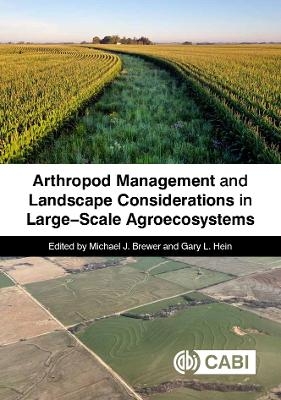
Arthropod Management and Landscape Considerations in Large-Scale Agroecosystems
CABI Publishing (Verlag)
978-1-80062-275-3 (ISBN)
For large-scale agroecosystems, patterns of pest population increases (graded increases or abrupt outbreaks) and declines (graded suppression or abrupt crashes) vary considerably and are influenced by factors within crop fields and across broader landscape scales. Better understanding of pest population dynamics and the implications of spatial interactions on the function and development of pest management approaches are the main themes of this important book. The book builds from a 60+ year history of field-based pest management by focusing on the drivers of pest management in large-scale agroecosystems and the landscape-scale processes that affect these drivers and contribute to variation in pest outbreaks and suppression. These drivers include abiotic and biotic influences such as weather, spatial composition and arrangement of landscape elements, and widely applied managed inputs such as planting and crop rotation schedules, crop varietal selection, and land and soil conservation efforts. The book introduces general concepts, opportunities, and challenges of arthropod management in large-scale agroecosystems. Case studies from major field crop-based agroecosystems are used to present research approaches and improve understanding and management of pest and beneficial insects in large-scale agroecosystems. Specific research findings are provided on multi-trophic interactions within the system as influenced by climate, landscape, and other ecological, agricultural, and social/economic components of the agroecosystem. The book concludes with a synthesis of these concepts and prospectus for future research and developments in arthropod management in large-scale, plant-based agroecosystems. The book is essential reading for researchers in applied entomology and ecology and for pest management practitioners.
Michael J Brewer (Edited By) Michael Brewer, Ph.D. is Professor of Entomology. His research, outreach and teaching interests bridge across field crops entomology, applied ecology, and integrated pest management. His focus is on transforming research findings undergirded by population, landscape, and pest and invasive species ecology to arthropod pest management approaches suited to large scale agroecosystems. Dr. Brewer has published 140 articles and 10 book chapters. Dr. Brewer is co-Editor-in-Chief of the Journal of Economic Entomology. Gary L. Hein (Edited By) Gary Hein, Ph.D is Professor of Entomology and Director of The Doctor of Plant Health (DPH) Program. He has extensive experience in research and extension efforts across a diverse set of entomological problems in multiple crops. He now teaches and administers the DPH Program, an interdisciplinary professional program. His current research efforts focus on aspects of the biology and ecology of the wheat curl mite that impact the epidemiology of the three serious viruses that the mite transmits to wheat. Dr. Hein has published over 100 refereed articles, 8 book chapters, and over 100 Extension publications.
Section I: Concepts, Opportunities, and Challenges of Arthropod Management in Large-scale Agroecosystems Chapter 1: Influence of Spatial Scale on Landscape Effects Important to Arthropod Management. Chapter 2: Pest Management for Spatially Variable Arthropod Pests in Large-scale Agroecosystems. Section II: Case Studies of Arthropod Management in Context of Spatial Scale Dynamics and Ecological, Agricultural, and Socio-Economic Considerations Chapter 3: Landscape Considerations in Pest Management: Case Study of the Arizona Cotton IPM System. Chapter 4: Managing the Invasive Fall Armyworm in the Large- and Small-Scale Maize Farming Landscapes of East and Southern Africa. Chapter 5: Aphid Biological Control by Parasitoids in Winter Wheat and Canola in Heterogeneous Agricultural Landscapes. Chapter 6: Ecology of Aphid Parasitoids in Winter Wheat Habitats of the Southern Plains: How Latitude and Crop Diversity Influence Pest Management. Chapter 7: Cereal Aphids and Yellow Dwarf Viruses Among Wheat and Other Large-Scale Agroecosystems of Central North America. Chapter 8: Natural Enemy Suppression Supplemented by Regional Pest Management for the Invasive Melanaphis sorghi, Sorghum Aphid, on Sorghum. Chapter 9: Western Corn Rootworm Resistance to Bt Maize within the Midwestern Agricultural Landscape. Chapter 10: Linking Corn Earworm Populations and Management to Landscapes Across North America. Chapter 11: Nature’s Workforce: Understanding the Role of Wild Bees’ in Agroecosystems. Chapter 12: Honey Beekeeping in Agricultural Landscapes: Addressing the Stresses of Pesticide Exposure and Limited Forage. Section III: Information Systems and Molecular Tools to Advance Arthropod Management in Large-scale Agroecosystems Chapter 13: Future of Information Systems for Pest Management: Data Acquisition and Integration to Guiding Management Decisions. Chapter 14: Past, Present, and Future Applications of Molecular Tools in Landscape Scale IPM: Fall Armyworm as a Case Study.
| Erscheinungsdatum | 21.08.2024 |
|---|---|
| Co-Autor | Kristen Baum, Mahendra Bhandari, Haley Butler |
| Verlagsort | Wallingford |
| Sprache | englisch |
| Maße | 172 x 244 mm |
| Themenwelt | Naturwissenschaften ► Biologie ► Zoologie |
| Weitere Fachgebiete ► Land- / Forstwirtschaft / Fischerei | |
| ISBN-10 | 1-80062-275-9 / 1800622759 |
| ISBN-13 | 978-1-80062-275-3 / 9781800622753 |
| Zustand | Neuware |
| Informationen gemäß Produktsicherheitsverordnung (GPSR) | |
| Haben Sie eine Frage zum Produkt? |
aus dem Bereich


